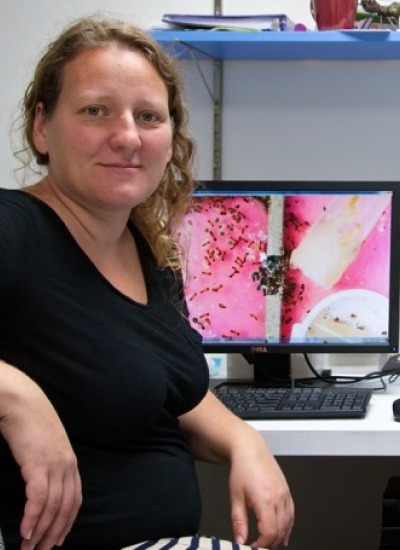Anna R Dornhaus
Publications
Abstract:
The automated tracking of social insects, such as ants, could dramatically increase the fidelity and amount of analyzed data for studying complex group behaviors. Recently, data association based multiple object tracking methods have shown promise in improving handling of occlusions. However, the tracking of ants in a colony is still challenging as (1) their motion is often sporadic and irregular and (2) they are mostly present the entire duration of video. In this paper, we propose to improve the data association based tracking of multiple ants. First, we model the ant's motion using a set of irregular motion features including random walk model. Second, we use the convergence of particle filter based tracking to match tracklets with a long temporal gap. Testing results of two-fold cross validation on a 10,000 frame video shows that our proposed method was able to reduce the number of fragments by 61% and ID switches by 57%. © 2013 IEEE.
PMID: 17148163;PMCID: PMC1626204;Abstract:
House-hunting ants avoid otherwise excellent potential nest sites that contain dead ants which may pose risks from poor hygiene. This discovery adds another category to the exceptionally long list of nest site attributes that ants evaluate. It further indicates the importance of disease as a selection pressure on social insects. © 2005 The Royal Society.
Abstract:
Motion and behavior analysis of social insects such as ants requires tracking many ants over time. This process is highly labor-intensive and tedious. Automatic tracking is challenging as ants often interact with one another, resulting in frequent occlusions that cause drifts in tracking. In addition, tracking many objects is computationally expensive. In this paper, we present a robust and efficient method for tracking multiple ants. We first prevent drifts by maximizing the coverage of foreground pixels at at global scale. Secondly, we improve speed by reducing markov chain length through dynamically changing the target proposal distribution for perturbed ant selection. Using a real dataset with ground truth, we demonstrate that our algorithm was able to improve the accuracy by 15% (resulting in 98% tracking accuracy) and the speed by 76%. © 2010 IEEE.
Abstract:
Floral signals are typically emitted across multiple sensory modalities, although why they are multimodal is unclear. One possible explanation is that multimodal signalling ensures that at least one signal component will be transmitted effectively under varying environmental conditions (the 'efficacy backup' hypothesis). For example, by transmitting both component A and B, a signaller can communicate under environmental conditions where transmission of component A is reduced; component B 'backs up' A. To test this hypothesis, we determined whether a floral scent could back up a floral colour signal when light levels were low. We trained nectar-foraging bumblebees to discriminate rewarding and unrewarding targets that differed in colour, scent, or both colour and scent, and then presented the targets at different levels of illumination. We measured bees' accuracy at distinguishing the two targets and their rate of visits to the trained target. Performance on both measures declined under low light when targets were unscented. The presence of scent reduced the loss of accuracy under low light, supporting the efficacy backup hypothesis, but this effect depended upon the colour of the previously rewarded target. In contrast, the presence of scent did not affect the overall rate of correct visits under low light (correct visits/foraging time). A backup mechanism that maintains accuracy, but not rate of nectar collection, does not necessarily benefit the pollinator. However, it most likely benefits the plant through reduced pollen wastage. In short, multimodal floral signals may benefit the plant by improving pollen transfer, while not benefiting the pollinator. © 2012 The Association for the Study of Animal Behaviour.
Abstract:
The return of a successful bumblebee forager stimulates nestmates to leave the nest and search for food. Here we investigate the mechanisms by which this happens. Successful Bombus terrestris foragers perform irregular runs in their nest, often lasting for several minutes. Run duration is at its maximum when food has just been discovered. Running likely serves to distribute a pheromone, since the information flow between "runners" and "recruits" can be disrupted by eliminating air exchange, while leaving other potential means of communication intact. In addition, nectar stores in the nest may be monitored continuously. A sudden influx of nectar into the nest also causes measurable increases in forager activity. The implications of bumblebee recruitment behavior for the evolution of communication in bees are discussed.


